Phyllostachys Pubescens Moso
Phyllostachys pubescens is the largest running bamboo that grows well in temperate climate. Because of sporadic flowering that is happening all the time, seed availability isn’t as problematic as with other bamboos.

| Basic information: |
| Height: 25 m Culm diameter: 18 cm Hardiness: -18 °C Characteristics: fuzzy culms, Large leaves as seedling, small leaves when mature, upright growth, strong culms, running bamboo, sun tolerant |
First package of seeds gave poor results with 0% germination rate. Not even one of the seeds germinated, because they were most likely old and had lost their viability. Bamboo is known to loose viability with age. One way to keep the seeds viable is by keeping them in the refrigerator. When it got apparent that all seeds were dead and I couldn’t get even one single seedling out of whole batch, I decided to order another package from different supplier, that claimed to have fresh seeds. This time, germination rate was quite good and I had more seedlings that I could took care of.

Phyllostachys pubescens seeds were placed into warm water for 24 hours after I received them. Some of the seeds sank to the bottom, and some floated even after soaking in water. Those that were floating were either dead or empty – grains must have fell out already.
I used wet paper towel to keep the seeds moist. Seeds were placed into zip lock bag to prevent the paper towel to dry out. By checking seeds on a daily basis, I could see when they began to germinate. If mold appears on paper towel or on seeds, they should be rinsed with water and placed into fresh towel. Paper towel have to be moist but not wet. It’s best to squeeze out almost all the water, before finally placing it into zip lock bag.

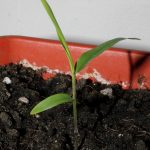
At first, seedlings were growing fast and seemed very healthy. Soil needs to be well drained, or else seedlings fail at the very beginning. Tiny pubescens are delicate when it comes to watering. It’s usually better option to wait a couple of days longer before watering than overwatering. It’s also good to keep the seedlings in smaller pots and re-pot them as they grow bigger. Larger pots are harder to control.
Soon after bamboos started shooting for the first time, problems started to appear. Without any warning leaves started to appear chlorotic. Yellow stripes started to appear between leaf veins. Not even one seedling was safe from getting nutrition deficient. Adding liquid fertilizer did not seem to help much after the deficiency was spotted, but if added before it happened, everything seemed OK.

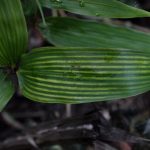
Before taking bamboos outside in the spring, they were growing slower, but appeared to be healthier. Outside, rain, strong wind and sun exposure made them suffer. Despite everything, they started to grow faster with each additional leaf. Seedlings soon grew into nice little clusters of culms. Every shooting cycle there were more and more new shoots that were larger in diameter and height.
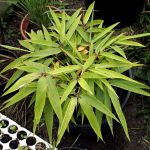

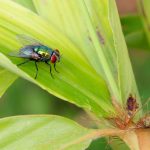
Most of the seedlings died during the hot summer, because I never protected pots from overheating. Surviving seedlings became chlorotic, their growth was stunted, new shoots started to abort soon after emerging, growing tips were not unfolding, … All symptoms of nutrient deficiency, but it could not be prevented. Adding fertilizers did not help and I tried foliar feeding, slow release fertilizer, liquid fertilizer, manure and mulch. Only one seedling started shooting in the fall, others remained poor performers even after they got planted outside into the ground.
During the first year, I learned that pots have to get buried into the soil to prevent pot soil overheating. I also learned that I used way too much peat moss that acted as a sponge, locking all the water inside the pot and drowning the roots.

All seedlings were placed into the ground the following year, the best looking one remained in it’s pot, others were placed directly into the ground. It didn’t help them much, they are still performing poorly in their third year. After taking care of the pots, there were no more deficiency issues. During the second year, the best looking seedling (that was still inside it’s pot) started growing rhizomes and escaped the pot on several places. Small but healthy looking clump was not growing much during the summer, but there was a lot of underground activity. In the autumn, I took off one of the escaping rhizome that poked out as whip shoot and successfully tried making a division.
After winter, seedling remained at the same spot, with some minor winter damage, but most of the rhizomes and culms remained alive. There was some leaf and growing tips damage. Thanks to a lot of snow, soil was well protected from cold temperatures.
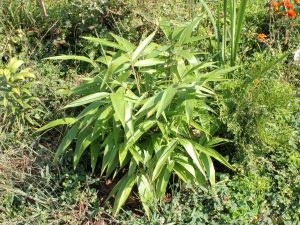
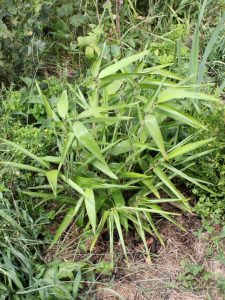
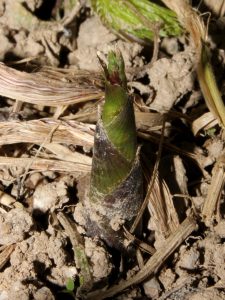

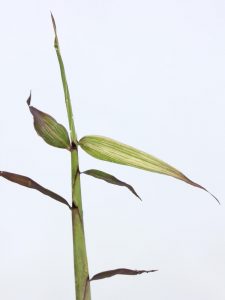
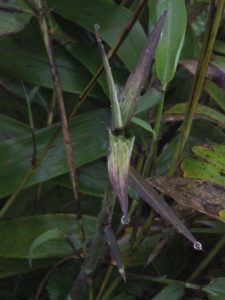
Shooting started in the end of April 2013. The escaping rhizome put out 4 shoots, yet 2 of them aborted soon after they emerged. Shoots on that escaping rhizome were maturer than those inside the pot. Some of the shoots appeared red with yellow leaves. Abundance of shoots made it and only a couple of them aborted. When shoots started branching out, all new shoots started showing variegation. The red shoots were more variegated than others that appeared green from the start. Variegation completely dissappeared after a couple of weeks and will most likely return next spring.

In late August, fat rhizomes started to crawl around the escaped culms which means there will be quite an upsize when buds on those rhizomes mature. Inside the pot, there are numerous whip shoots that might harden enough before the first frost, but will most likely fail to do so in time.


New rhizomes are thick and they tend to spread their roots quite fast. I’ll try to make sure they are well protected during the winter, like they were last year.
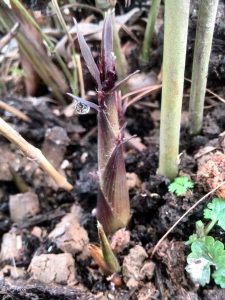

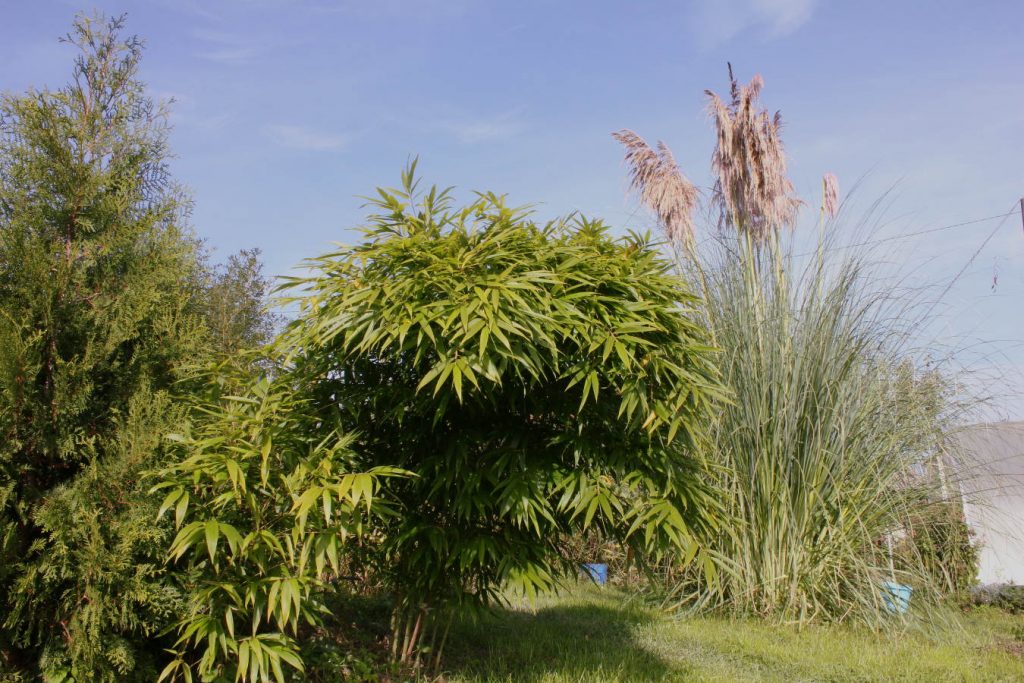

9 thoughts on “Phyllostachys Pubescens Moso”
Hey! If you could make a blog post about how you’re preparing your moso for the winter, I would be very happy! I’m keeping my moso indoors this second winter, but next spring I am planting some of them outside in the ground and some I’ll be keeping in pots for comparison, and put in the greenhouse for the winter (5-15C all winter).
Last year’s low was -16,9, and the year before it was -12, so it fluctuates. Never gone below -21, but that still goes to show that cold spells do come by, and they’re devastating if they linger.
I will write about winter preparations. Moso is not the most problematic for me, as I have a much less hardy bamboo – Borinda fungosa, that really needs any kind of protection I can offer.
Down to -10°C Moso usually shows little or no damage. It does get damaged, however, when there’s cold sunny weather with cold dry winds. If it remains frozen during the day, wind and sun will suck the water out of it in no-time. When it’s covered with snow, there’s only little or no damage at all.
Even -20°C should not be fatal for the bamboo. It will most likely get top-killed or at least lose some of its culms, but it will bounce back in the spring. My Moso seedling survived -20°C half fried. By half fried I mean, the southern half without snow protection got completely defoliated, the northern, shaded side of the clump only showed minor leaf damage.
But you did give it some extra protection (Agribon covers or mulch etc.) the first winter[s] int he ground, didn’t you? We will have a whole week where temperatures will not go above freezing on particularly cold winters, which makes me worry about ground frost. I guess mulching is there to help protect against that.
Thank you for sharing your experiences! I really appreciate it!
No additional protection. I did give it a couple inches of mulch, grass clippings and there were some dry bamboo leaves, but not much. The soil can freeze and bamboos will survive, the thing is, if they get too wet during that time, or shortly after, their roots and rhizomes can get damaged enough for the small plant to perish.
Mulch is a good way to protect it. If you cover it with the cover you mentioned, they will be even more protected. If they get covered with snow, before the severe cold arrives, the protection will be even better. Under thick layer of snow, there’s usually only minor damage, or no damage at all.
I will remember this 🙂 Thank you. I feel a lot more confident about overwintering my Moso now.
Can I link to buy bamboo seed
Do you need bamboo seeds or are you trying to sell them and place a link? in the first case, there are lots of seeds on e-Bay and Aliexpress you can purchase. I have had great success with those. If you want to place a link, then no, sorry.
Hello
I want to plant r this bamboo
Is it very invasive?
Phyllostachys pubescens Moso Bambú
thanks josep barcelona catalunya
Hi,
it is just as invasive as other Phyllostachys bamboos. When mature, canes are usually not as densely clumped like culms of other Phyllostachys bamboos. It surely needs some “love” each year to control its underground growth. I do it twice a year, and I have it under control. If (when) it runs away, I can always dig a bit deeper and cut off the escaping rhizome.
In Spain or Catalonia, it would most likely grow faster and the season lasts longer as well. This means it would also spread a bit more vigorously. I would definitely recommend rhizome barrier.